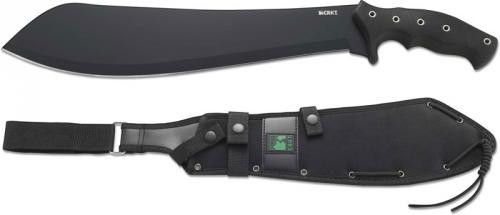|
HALFACHANCE Parang  There are a lot of manufacturers cranking out cheap machetes/parangs for the big box stores. And many of them are well known names, which is unfortunate, because all of them use a budget-grade steel. The most common steel used is 3Cr13 which is equivalent to 420J2. This is a soft steel, it has lousy edge retention and if that isn’t bad enough, it chips, nicks and bends. As such, when you are in the market for a machete or parang, check out the steel before you check out. For the record, there is not a single knife in the CRKT collection which uses 3Cr13 steel. That includes Ken Onion’s HALFACHANCE Parang. It utilizes 65Mn carbon steel, which is recognized as being ideal for large knives, swords, parangs and machetes. 65Mn is a true tool steel, well known for its hardness and durability. However, it will not hold an edge like an EDC blade, but you are working it a lot harder, so expect to sharpen it after a days hard use. The only drawback to 65Mn is that it is not corrosion resistant. With that in mind, CRKT/Ken Onion applied a black powder coating on the blade for corrosion-resistance. This coating is tough and very durable. It does prevent corrosion in humid environments. At this point, some of you may be wondering what is the difference between a “standard” machete and a parang. Machetes have long thin blades, usually only a few millimeters in thickness. Their power comes from the wrist and are good for hacking through thin foliage like vines and thin saplings. It is a standard work tool in the jungle and rain forests of Central America. Whereas the parang was developed in areas where the growth was more woody and heavier, such as Malaysia. ( and North America). Heavier and more woody foliage requires a broader, heavier and thicker blade with more weight. You swing the parang using your shoulder and it will make short work of even a three inch woody branch. For North American outdoorsmen, we recommend the parang rather than a machete for use around the base camp or when you venture into the unknown. We would also like to point out another difference between the two blades. Most, if not all, imported machetes have a very flimsy sheath. It barely does its job and will wear out after one or two seasons. Whereas, the CRKT parang has a very, very robust nylon sheath that is superbly constructed for a lifetime of use and wear. Just thought we'd throw that in as the sheath stands above and apart from others in its category. If you get the picture, the parang is a great tool and Ken Onion's HalfaChance Parang is outstanding.... in every way. I guess we can say it is “typical Ken Onion”, as he doesn't just make blades, he designs them for a specific purpose. The HALFACHANCE is just one of many superb blades designed by Ken. The specifications for the HALFACHANCE are:
Ken designed the HALFACHANCE for the outdoorsman. The weight-forward blade and ergonomic handle provide maximum cutting power with minimal hand fatigue. There is literally no task too big or small for this blade. We recommend it without reservations. |